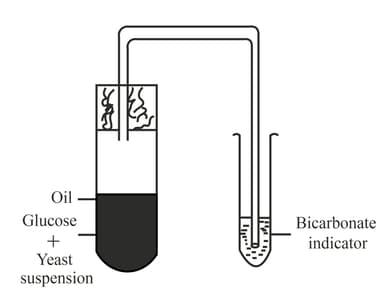Pyruvate can be converted into ethanol and carbon dioxide by Yeast.
Important Questions on Respiration in Plants
(A) Acetaldehyde Ethanol
(B) Glyceraldehyde Phosphate - phosphoglyceric acid
(C) Pyruvic acid lactic acid
(D) Oxalosuccinic acid ketoglutaric acid
(E) ketoglutaric acid succinyl
Respective products released along with main product in biochemical reactions catalysed by given enzymes
A) Glutamine synthetase I) NADH + H+
B) Fructose 1,6-bisphosphatase II) ADP + Pi
C) Hexokinase III) Inorganic phosphate
D) Malate dehydrogenase IV) ADP
(A) Glycolysis has chain reactions.
(B) In glycolysis, ATP is utilised in one step.
(C) There is one step related to the formation of .
(D) Glycolysis can take place in the mitochondria matrix also.
Assertion (): Anaerobic respiration yields less energy utilizing oxygen.
Reason (): In anaerobic respiration, energy is released due to the incomplete breakdown of organic molecules.
Which ONE of the following statements is INCORRECT about the hexokinase-catalysed reaction given below?
Glucose ATP Glucose--phosphate+ADP
Arrange the given reactions occur in electron transport in correct sequence.
Oxygen Removes from ETS Receives electrons form .
Ubiquinone Oxidized from ubiquinol Receives reduced equivalents from .
Cyt C oxidase Reduced by cytochrome Electron donor for to release .
Cytochrome Mobile carrier Transfer from cyt to cyt oxidase.
Assertion (A) :- The pathway from glucose to lactic acid occurs in metabolic steps. Organisms will trap this energy and store in the form of chemical molecules.
Reason (R) :- Glucose is the only substrate for the production of energy.
The correct option among the following is:
Assertion (A): When electrons move through the transport chain, protons are transported across the membrane.
Reason (R) : Because the primary acceptor of electron located towards the outside of the membrane, transfers its electrons to a H carrier (PQ).
The correct option among the following is:
| List-I | List-II | ||
| A | Phosphoenol pyruvate | I | Hexokinase |
| B | Pyruvic acid | II | Enolase |
| C | Triosephosphate | III | Pyruvic kinase |
| D | Glucose-—phosphate | IV | Aldolase |
The correct match is:
The figure given below is designed to show yeast respiration. In one of the tubes, there is yeast suspension in glucose solution. This solution was boiled before yeast was added to it. Which one of the following is the possible reason for boiling sugar solution?


